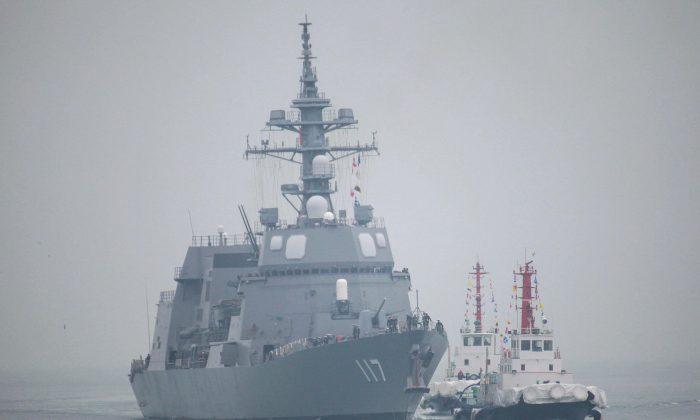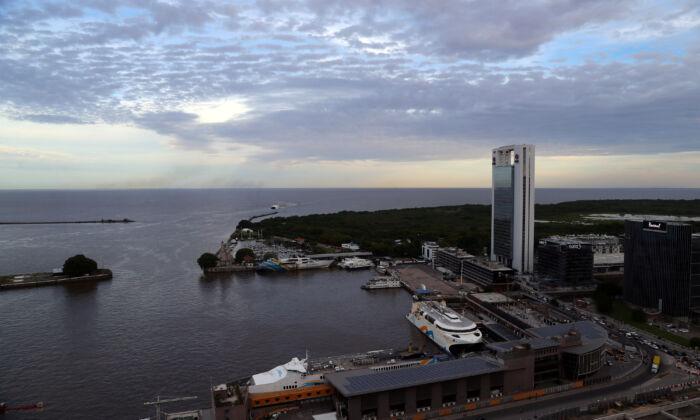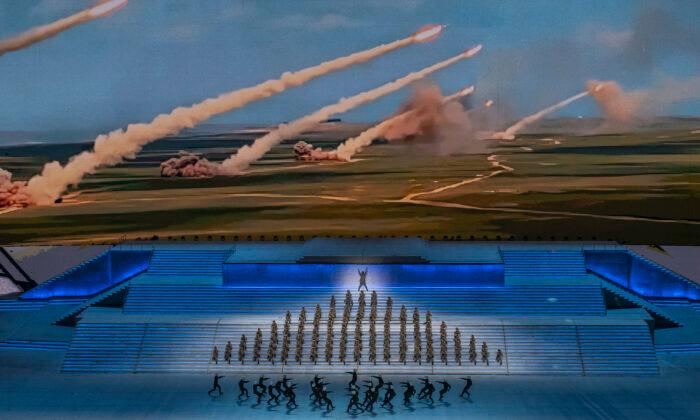This week, China’s military propagandists are going into high gear, using the 70th anniversary of the People’s Liberation Army (PLA) Navy to hail it as a force for peace.
However, the facts demonstrate that China already is using its increasingly powerful navy to seek regional hegemony, with the future goal of achieving global military hegemony.
On April 20, the PLA Navy held a press conference to preview its 70th-anniversary celebration program this week, which will include a large naval parade with participating ships from 10 countries. During the press conference, PLA Navy Deputy Commander Admiral Qiu Yanpeng declared, “The PLA Navy is always a force of peace, and will never pose a threat to any other country.”
Yet, on April 15, five days before the press conference, PLA Navy frigates and resupply ships were conducting joint military exercises on the east side of democratic Taiwan with a formation of 24 PLA Air Force bombers, electronic surveillance aircraft, and fighter aircraft—the largest to date. This exercise coincided with celebrations in Taiwan of the 40th anniversary of its unofficial relationship with the United States, codified in a unique law, the 1979 Taiwan Relations Act.
In January, a PLA Navy group sailed into the South China Sea to conduct a joint exercise with the PLA Rocket Force, which has long-range anti-ship ballistic missiles (ASBMs) intended to sink large ships, such as aircraft carriers, thousands of miles from land bases.
These were just the latest in two years of similar PLA exercises intended to demonstrate to the Taiwanese that the United States cannot defend them from Chinese attack. Analysts are increasingly concerned that China may complete preparations to invade Taiwan by the early- to mid-2020s.
During the first week of March, the PLA-controlled Coast Guard sent four ships to circle Japan’s Senkaku Islands to demonstrate Beijing’s ire that Taiwan and Japan were going to hold talks over fishing rights.
Future Threat
The Trump administration, to its credit, decided in early April that the U.S. Navy would not send any ships to join the PLA Navy’s 70th-anniversary celebrations. China is using its naval power to threaten Japan and the Philippines, and to prepare to invade Taiwan, the conquest of which is necessary for the survival of China’s Communist Party dictatorship and for its plans to dominate Asia and then the world.By 2029, should the PLA Navy celebrate its 80th anniversary, it can be expected to be far more powerful. By then, it will have launched one or two nuclear-powered aircraft carriers, to add to three non-nuclear-powered carriers.
It may also have nuclear-powered cruiser escort ships and nuclear-powered large supply ships. The PLA Navy could have the world’s first all nuclear-powered aircraft carrier battle group. From Chinese bases, such a battle group would be fast enough to reach New Zealand in five to six days.
China’s carriers may be armed with fifth-generation combat aircraft and supporting airborne warning and control system aircraft. China’s large combat ships and submarines could also be armed with hypersonic glide vehicle (HGV) long-range ballistic missiles, posing a threat to U.S. and allied ships out to ranges of thousands of miles.
By 2029, PLA Navy ship-launched ballistic missiles will join land-based PLA Rocket Force ASBMs, PLA Air Force air-launched ballistic missiles, and very likely, PLA Strategic Support Force bombing platforms in Low Earth Orbit.
In addition, in a decade, the PLA Navy will have a larger “Gator Navy” of large amphibious assault ships to include 14 or more Landing Platform Dock, and new Landing Helicopter Dock (LHD), large assault ships, to project PLA Marine Corp forces around the world.
China already is using its growing commercial strength, and debt-trap strategies such as its “One Belt, One Road” initiative, to gather a global network of bases to enable its military maritime projection. Today, China uses its strength to prop up anti-human dictatorships like Iran, North Korea, and Venezuela, and it if gets the chance, will seek to subordinate all free societies.
As such, it is necessary to deny China’s navy the political legitimacy that would be conferred by the U.S. Navy’s participation in the PLA Navy’s 70th-anniversary celebration. The United States must make clear that the Chinese Communist Party leadership’s current maritime and military trajectory is leading to military conflicts that it will lose.
This starts with U.S. officials regularly explaining why the U.S. Navy did not join the PLA Navy’s 70th anniversary, including a list of China’s ongoing maritime aggressions, Beijing’s refusal to end its commerce with North Korea in violation of United Nations sanctions, and its economic and political support for terrorist dictatorships in Iran and Venezuela.
Then, it’s necessary for the United States to rearm its Navy to be able to win future wars against China and Russia. Trump administration plans to put submarine-launched and tactical nuclear warhead-armed Tomahawk cruise missiles back into production should be accelerated. The U.S. Navy also requires its own ship-launched HGV-armed ASBMs, and powerful laser weapons to defend against this weapon.
To supplement its 10 or so large $13-billion Ford-class nuclear-powered aircraft carriers, the United States should develop a larger 55,000-ton version of its $4-billion America-class LHD, which can carry a mix of 40 stealth fighters, unmanned combat aircraft, and support helicopters, but those that also are armed with 100 to 200 vertical launchers for defensive missiles and offensive ASBMs.
With long-range anti-ship and land-attack ballistic missiles spread across its destroyers, attack submarines, and prospective frigates—and a new class of smaller, ballistic missile-armed aircraft carriers supplementing larger carriers—by 2029, the U.S. Navy could be much better armed to dissuade and deny China’s plans for global maritime hegemony.






Friends Read Free